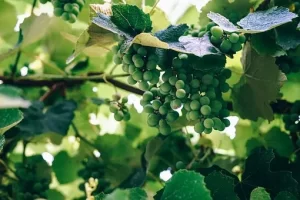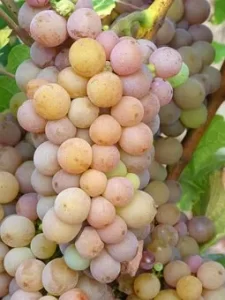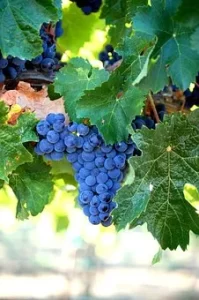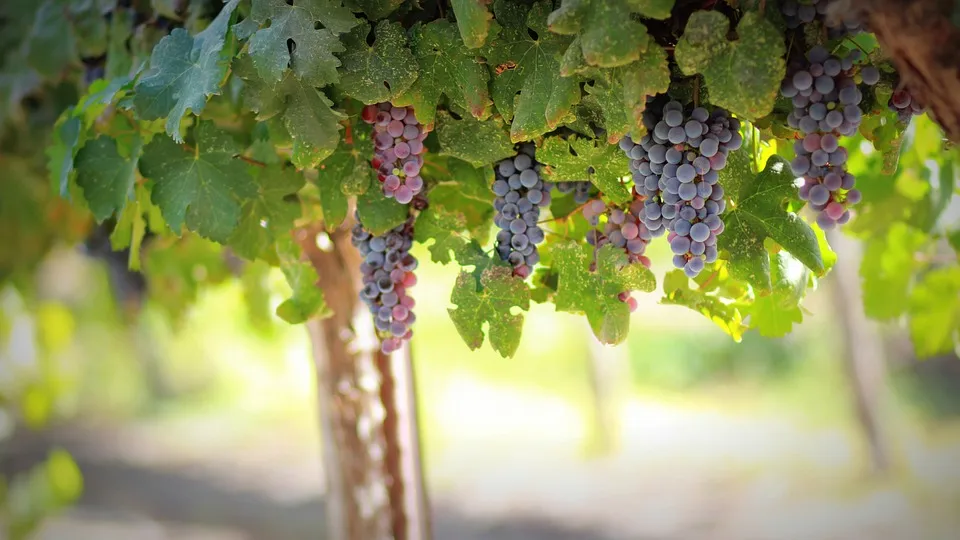North Carolina is home to numerous wineries, many of which grow their own wine grapes. The state is home to both cool and warm climate varietals, and several hybrid varieties as well. Popular wine grapes that are found in North Carolina include Cabernet Sauvignon, Chardonnay, Pinot Gris, Merlot, and Syrah.
The Grapes!
Cabernet Sauvignon
Cabernet Sauvignon is one of the most popular and widely grown wine grapes in the world. It is a dark-skinned grape variety that is known for its deep color, intense tannins, and robust flavors.
Cabernet Sauvignon is a cross between Cabernet Franc and Sauvignon blanc and is the backbone of some of the world’s most famous blends. This noble varietal is highly valued for its strong structure, structure that can stand up to the bold flavors of food like steak and aged cheeses.
Cabernet Sauvignon is best grown in cooler climates and needs plenty of sunshine to fully ripen. In general, this grape is often planted in the warmer regions of the United States, where it can thrive. Wines made with Cabernet Sauvignon often have a deep color, with a blackberry, cassis, and dark cherry flavor profile.
Food pairing for Cabernet Sauvignon
When it comes to food pairing, Cabernet Sauvignon pairs well with red meats, game, and hard cheeses. It can also have a beautiful balance when paired with dishes that contain tomatoes, mushrooms, and herbs.
Chardonnay
 Chardonnay is a green-skinned grape variety, related to the Pinot Noir grape, and is usually vinified in a dry white wine style. Chardonnay can range in flavor from light and crisp to buttery and oak-influenced.
Chardonnay is a green-skinned grape variety, related to the Pinot Noir grape, and is usually vinified in a dry white wine style. Chardonnay can range in flavor from light and crisp to buttery and oak-influenced.
Chardonnay’s popularity is due to its wide range of flavors, ranging from green apple and citrus fruits to tropical fruits, and its ability to pair well with many different foods. It is often used to produce sparkling wines, as well as light and fruity still wines. Chardonnay is also often aged in oak barrels, imparting a unique flavor profile of buttery, toasty, and oaky notes.
Chardonnay is a versatile grape variety, and can be blended with other grape varieties to create complex and interesting wines. It is also a popular grape for making sparkling wines, as well as sweet dessert wines.
Chardonnay is an easy grape variety to grow, and is often grown in cooler climates, where it ripens early and produces wines with higher acidity. Chardonnay is an ideal grape for beginner winemakers, as it is easy to work with and generally produces good results.
Pinot Gris
 Pinot Gris, also known as Pinot Grigio, is a white wine grape variety that is a member of the Pinot family and is closely related to Pinot Noir. It is a relatively new variety, first appearing in France in the late 19th century and is now grown in many countries around the world. The grape is highly versatile, producing wines that range from light and crisp to full-bodied and rich.
Pinot Gris, also known as Pinot Grigio, is a white wine grape variety that is a member of the Pinot family and is closely related to Pinot Noir. It is a relatively new variety, first appearing in France in the late 19th century and is now grown in many countries around the world. The grape is highly versatile, producing wines that range from light and crisp to full-bodied and rich.
Pinot Gris wines tend to be light to medium-bodied with a pale yellow hue. They are often characterized by aromas of citrus, melon, pear, honey, and floral notes. On the palate, Pinot Gris wines are typically dry with a subtle sweetness and a crisp acidity. The flavors are often delicate, featuring flavors of apple, pear, citrus, honey, and sometimes a minerally note.
Pinot Gris is a relatively low-yielding variety, and as such, is often blended with other white grapes to increase the quantity of wine produced. It is a popular choice for sparkling wines, as well as for many crisp, dry white wines.
Overall, Pinot Gris is a versatile grape variety that can produce a wide range of styles of wines, from light and crisp to full-bodied and rich. It is an excellent choice for sparkling wines and sweet wines, and is also a popular choice for many crisp, dry white wines.
Merlot
 Merlot grapes are large, round and dark blue with thick skins. They have a sweet, fruity flavor and are usually used in wines that are full-bodied and smooth. Merlot wines are usually aged in oak barrels, which lends them a characteristic woody flavor.
Merlot grapes are large, round and dark blue with thick skins. They have a sweet, fruity flavor and are usually used in wines that are full-bodied and smooth. Merlot wines are usually aged in oak barrels, which lends them a characteristic woody flavor.
Merlot wines are typically quite fruity, with notes of blackberry, cherry, plum, and sometimes chocolate. They tend to be less tannic than cabernet sauvignon, which makes them more approachable for many drinkers. Merlot pairs well with a variety of dishes, including red meats, poultry, and pasta dishes.
Merlot has become increasingly popular in recent years, and is now one of the most widely planted grapes in the world. Its popularity is due to its versatility and its ability to be blended with other grapes to create complex and interesting wines. Merlot is an excellent choice for those looking to explore the world of red wine.
Syrah
Syrah is a dark-skinned wine grape native to the Rhone Valley in France. It is also known as Shiraz in parts of the world such as Australia and South Africa. Syrah is one of the most widely planted red wine grapes in the world and is used to produce a variety of red wines ranging from light and fruity to full-bodied and tannic. It is often blended with other varieties such as Grenache, Mourvedre, and Viognier.
Syrah has a deep, inky color with aromas of dark fruits such as blackberry and blueberry, as well as notes of spice, pepper, and earth. On the palate, Syrah is full-bodied and has a rich, velvety texture. The flavors can range from dark fruits to leather, tobacco, and gamey notes.
Syrah has moderate to high tannins and moderate to high acidity, making it a great food wine. Syrah pairs well with a variety of dishes, from game meats to grilled vegetables and tomato-based sauces. It is also a great choice for BBQs and barbecued meats. Syrah is a great choice for any occasion, from casual get-togethers to more formal dinners.
Hybrid Grapes
In addition to these popular varietals, North Carolina is home to many hybrid varieties. These hybrids are created to better withstand the warmer climate of the state. Popular hybrids grown in North Carolina include Seyval Blanc, Traminette, Vidal Blanc, and Chambourcin.
Seyval Blanc
 Seyval Blanc is a white wine grape variety that is grown in the cool climate regions of Europe and North America. It is a hybrid variety created by crossing the French grape Seibel 5279 with the German grape Müller-Thurgau. Seyval Blanc is a vigorous, disease-resistant variety that produces neutral, acidic wines with floral and citrus aromas.
Seyval Blanc is a white wine grape variety that is grown in the cool climate regions of Europe and North America. It is a hybrid variety created by crossing the French grape Seibel 5279 with the German grape Müller-Thurgau. Seyval Blanc is a vigorous, disease-resistant variety that produces neutral, acidic wines with floral and citrus aromas.
The wines made from Seyval Blanc tend to be light-bodied and low in alcohol, with a crisp, mineral-driven acidity. They are often used as a blending partner with other grape varieties to add acidity and structure to the blend. Seyval Blanc wines are often described as being light, fresh, and slightly floral, with notes of green apple, pear, and citrus.
Seyval Blanc is a popular grape variety for sparkling wines, and is often used in the production of English sparkling wines. It is also used to make white wines, and is often blended with other varieties such as Chardonnay, Sauvignon Blanc, and Chenin Blanc.
Seyval Blanc is a versatile variety that can be used to make a wide range of wines, from dry to sweet. It is an excellent choice for cool climate regions, and can be used to make wines that are fresh, light, and easy to drink.
Traminette
Traminette is a white wine grape variety that was developed in the United States in 1972. It is a hybrid of the French grape Gewürztraminer and the American variety Joannes Seyve 23.416, and is a member of the Vitis vinifera family. The grape is known for its floral and spicy characteristics, and is most often used to produce semi-dry or off-dry wines.
Traminette has a thick skin which helps protect it from the elements, and is a very hardy grape variety. The grape is fairly resistant to powdery mildew and is tolerant of cold temperatures, making it a good choice for cooler climates. The grape is also high yielding and produces large clusters of small, yellow-green berries. The flavor profile of Traminette wines is quite distinctive and can range from sweet to semi-sweet, with notes of peach, apricot, honey, and spice. The wines are often described as having a “grapey” or “muscat-like” aroma, as well as a hint of rose petal. Traminette is most commonly used to make white wines, but can also be used to produce rosé and sparkling wines.
Vidal Blanc
Vidal Blanc is a hybrid of Ugni Blanc and Rayon d’Or, two French varieties, and is known for its high acidity and floral aromas. Vidal Blanc wines are often characterized by their light body, crisp acidity, and citrus and stone fruit flavors.
Vidal Blanc is a popular variety for making dry white wines, as well as sweet and sparkling wines. It is often blended with other grapes, such as Chardonnay and Riesling, to create complex and interesting flavor profiles. It is also used to make fortified wines and dessert wines, such as icewine.
Vidal Blanc is a hardy variety and is resistant to many vine diseases and pests, making it a popular choice for growers in cooler climates. It is also a relatively early ripening variety, which allows for an earlier harvest and more consistent yields.
Overall, Vidal Blanc is a versatile and popular variety that is well-suited for a variety of wine styles. Its high acidity and floral aromas make it a great choice for crisp and refreshing white wines, while its ability to be blended with other varieties allows for a wide range of flavor profiles.
Chambourcin
The Chambourcin wine grape is a hybrid variety, bred in France in the 1950s. It is a cross between two other French varieties, Cabernet Franc and Seibel 5279. It is a cold-hardy variety, making it well-suited to cooler climates.
Chambourcin is a medium-bodied red wine, with aromas of dark fruits, spices, and herbs. Its flavors are of cherry, plum, blackberry, and pepper, with notes of leather, tobacco, and oak. It has moderate tannins and a medium-long finish. Chambourcin is often blended with other varieties, such as Cabernet Sauvignon, Merlot, and Cabernet Franc.
Chambourcin wines can range in style from light-bodied and fruity, to full-bodied and intense. They can be aged in oak barrels, or enjoyed young. They are food-friendly and pair well with a variety of dishes, from grilled meats to pasta.
Summary
In recent years, North Carolina has seen an increase in the number of wineries and vineyards, as well as the number of different varieties planted. This has led to an increase in the diversity of wine grapes grown in the state, allowing for a more interesting variety of wines to be produced.
Overall, North Carolina is home to a wide variety of wine grapes, from classic varietals to hybrids that are better suited to the warmer climate. With the increasing number of wineries and vineyards, the state is becoming an increasingly important part of the wine industry.
